Related Research Articles

Black Creek Pioneer Village, previously Dalziel Pioneer Park, is an open-air heritage museum in Toronto, Ontario, Canada. The village is located in the North York district of Toronto, just west of York University and southeast of the Jane and Steeles intersection. It overlooks Black Creek, a tributary of the Humber River. The village is a recreation of life in 19th-century Ontario and gives an idea how rural Ontario might have looked in the early-to-mid-19th century. The village is a regular destination for field trips by schoolchildren from the Greater Toronto Area. It was opened in 1960 and is operated by the Toronto and Region Conservation Authority.
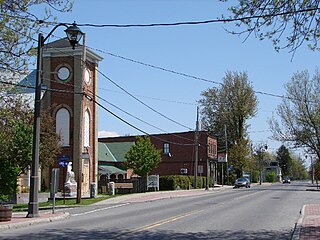
Cumberland is a former municipality and now geographic township in eastern Ontario, Canada. It was an incorporated township from 1800 to 1999, when it was incorporated as the City of Cumberland, then ceased to be a separate municipality in 2001, when it was amalgamated into the city of Ottawa. It now exists only as a geographic township.

Stormont—Dundas—South Glengarry is a federal electoral district in Ontario, Canada, that has been represented in the House of Commons of Canada since 1968.

South Glengarry is a township in eastern Ontario, Canada on the Saint Lawrence River in the United Counties of Stormont, Dundas and Glengarry.
Stormont County area 248,608 acres (1,006 km2) is a county in the Canadian province of Ontario.
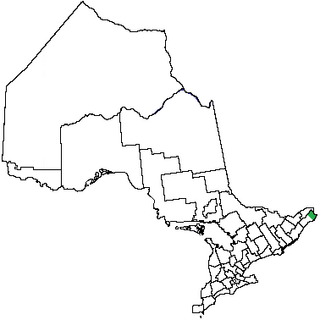
Glengarry County, an area covering 288,688 acres (1,168 km2), is a county in the Canadian province of Ontario. It is historically known for its settlement of Scottish Highlanders. Glengarry County now consists of the modern-day townships of North Glengarry and South Glengarry and it borders the Saint Lawrence River.
Prescott County is a historic county in the Canadian province of Ontario.

Vankleek Hill is a community in Champlain township in eastern Ontario, situated 94 kilometres east of Downtown Ottawa.
Horaceville is a historic site located on the Ottawa River in eastern Ontario, Canada. The site remained the property of the heirs of Hamnett Kirkes Pinhey until the 1970s, when the property was sold to the township. Today, The 88-acre (360,000 m2) heritage site is owned and operated by the City of Ottawa and Pinhey's home serves as a museum. The museum is open May 14 through August 31, Wednesdays to Sundays, 11 am to 5 pm. This location is also known as Pinhey's Point Historic Site. The property was designated by the City of Ottawa under Part IV of the Ontario Heritage Act as having cultural heritage value or interest. A bronze plaque erected on the site by the Ontario Heritage Foundation describes the property's history: "Hamnet Kirkes Pinhey 1784 - 1857 - A merchant and ship owner in his native England, Pinhey came to Upper Canada in 1820. For his services as King's messenger during the Napoleonic Wars, he received a 1000 acres land grant on the Ottawa River. Within a decade he had built up an estate which he named Horaceville after his elder son. In addition to a manor house and barns, it included mills, a store and church. Pinhey took a leading part in township and district affairs. He was appointed to the Legislative Council in 1847, served as Warden of the Dalhousie District, and as the first Warden of Carleton County. Horaceville remained in family hands until 1959 when it was purchased by the National Capital Commission."
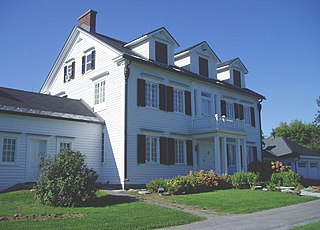
The Billings Estate National Historic Site is a heritage museum in Ottawa, Ontario, Canada. It is located at 2100 Cabot St. in the former home of one of the region's earliest settlers. The oldest wood-framed house in Ottawa was built in 1827-9 by Massachusetts-born Braddish Billings. It became the home for the following four generations of the Billings family. It is Ottawa's oldest surviving house, though the Bytown Museum building is older. Billings had moved to the area in 1812, and was the first settler in Gloucester Township.

The Museum of Appalachia, located in Norris, Tennessee, 20 miles (32 km) north of Knoxville, is a living history museum that interprets the pioneer and early 20th-century period of the Southern Appalachian region of the United States. Recently named an Affiliate of the Smithsonian Institution, the museum is a collection of more than 30 historic buildings rescued from neglect and decay and gathered onto 63 acres (250,000 m2) of picturesque pastures and fields. The museum also preserves and displays thousands of authentic relics, maintains one of the nation's largest folk art collections, and hosts performances of traditional Appalachian music and annual demonstrations by hundreds of regional craftsmen.
Pioneer Acres Museum is a museum located north of Irricana, Alberta, in Canada. The museum is located in Rocky View County in southern Alberta. Pioneer Acres is situated on 50 acres of land and includes over a dozen buildings. Pioneer Acres is at the north end of Irricana, Alberta only a 45-minute drive northeast of Calgary.

The Backus Heritage Conservation Area is located in Norfolk County, Ontario, Canada.

Doon Heritage Village, located at the Ken Seiling Waterloo Region Museum, is a picturesque 60 acre living history village that shows visitors what life was like in the Waterloo Region in the year 1914. It is located in the former Doon village, now part of Kitchener, Ontario, Canada, next to Homer Watson Park.

Markham Museum is a 25-acre (10 ha) open-air museum, located in Markham, Ontario, Canada. It is dedicated to the preservation of old buildings and artefacts from Markham's past, especially as a rural village has become an urban centre. The site features nearly 30 buildings: houses, barns, sheds, a train station, a school, a general store, a church, a blacksmith, a harness shop, a saw mill, a cider mill, and many more. One of the oldest buildings is the Hoover House, built in 1824 by a Mennonite family who were originally from Pennsylvania.

Stormont—Dundas—South Glengarry is a provincial electoral district in eastern Ontario, Canada. It was created for the 2007 provincial election. 95.5% came from Stormont—Dundas—Charlottenburgh while 4.5% came from Glengarry—Prescott—Russell.

Lang Pioneer Village Museum is a living history museum located in the hamlet of Lang in Peterborough County, Ontario. It was established in 1967 by the County of Peterborough. Lang Pioneer Village is situated on the shores of the historic Indian River. Lang Pioneer Village is an "outdoor museum" featuring more than 30 restored and furnished buildings, many of which were donated from the surrounding townships. The buildings, constructed between 1820 and 1910, are interpreted by costumed villagers portraying authentic 19th-century pioneer life. Since 2014 the Museum has been the site of the Aabnaabin Encampment, a pre-colonization representation of a Michi Saagiig camp where the story of the First Nations history and culture of the region is told by indigenous interpreters. Lang Pioneer Village Museum is owned and operated by the County of Peterborough.
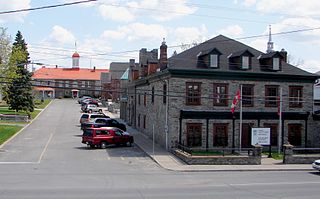
L'Orignal is a village and former municipality, now part of Champlain Township in eastern Ontario, Canada. It likely took its name from its location on the Ottawa River once known as Pointe à l'Orignal, where moose crossed the river.

Fanshawe Pioneer Village is an open-air museum established in 1959 and located in the Fanshawe Conservation Area in London, Ontario. The village uses historical re-enactments to communicate the history of rural communities in the former townships of Westminster, London, North Dorchester, Delaware, West Nissouri and Lobo in Middlesex County from 1820 to 1920 and the founding and development of the City of London up to 1840.
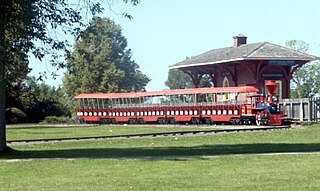
Morrisburg is an unincorporated community in the Municipality of South Dundas, located in Eastern Ontario, Canada.
References
- ↑ "About Us". glengarrypioneermuseum.ca. Archived from the original on 2015-04-13. Retrieved 2014-06-22.